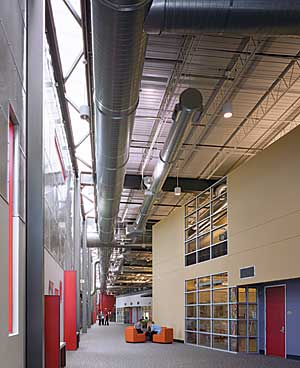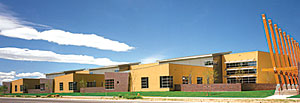An Abandoned Airport Brownfield Takes Off
Glycol
Of the three, glycol is the least hazardous, while jet and AV fuel require significant remediation. Over time, glycol, which smells like sewage owing to its tendency to generate large quantities of methane, will naturally biodegrade. Excavating glycol-contaminated soil and spreading it out on the ground to "air out" is an effective remediation method, but it obviously depends on the availability of large areas of land that can be requisitioned for what could amount to months of natural degradation. At Stapleton, open land was not a problem. "The developers wanted to develop a park with a sledding hill, so quite a bit of glycol dirt went into that hill because we knew it was going to be a park and would have a lot of clean, new soil packed over it," Wood said. Other glycol-contaminated dirt was allowed to biodegrade and then was returned to its original location.
 |
 |
| Klipp Architects' design for the Denver School of Science and Technology focused on exposing the structure and building systems in order to encourage vicarious learning among the students (top). The school (above) sits on land that was part of the Stapleton International Airport redevelopment project, one of the largest brownfield sites in the country. Photography: © Klipp/James H. Berchert Photography |
Jet and AV fuel
There are a number of ways to remediate petroleum contamination. At Stapleton, as with the majority of sites nationwide, excavating the soil and hauling it to a landfill was the easiest method to deal with the quantities of earth needed to be removed. However, this depended on the availability of clean infill dirt, which mostly came from new development excavations and grading, and it required ready access to an affordable landfill site. Wood noted that in denser urban areas, such as New York City, trucking dirt to a landfill can be prohibitively expensive. Alternative options to consider for this kind of contamination include bioremediation, similar to that undertaken for glycol, or cover and cap (sometimes called "engineered barriers"), where the contaminated soil is simply contained from further spreading. But, Wood adds, these methods would be inappropriate for residential development. Other methods, though less popular, include soil-vapor extraction, where air blown through soil strips it of hydrocarbons and then burns off in a catalytic oxidation chamber; and also phytoremediation, where specific plants are added to the landscape to naturally clean the soil. Chemicals for dissolving contaminants can be used in some instances, but were not considered at Stapleton. Wood said these other methods, in contrast to "dig and dump," would have taken too much time at Stapleton. Where airport buildings were preserved, remediation occurred around the perimeter and hot, soapy water was injected beneath the buildings and pumped out to "clean" the soil.
Tracking the dirt
Cleaning 4,700 acres of contaminated land presents a number of obstacles, chief among them the documentation process for distinguishing polluted zones and those that have been remediated. Balancing the assurance that the entire breadth of any one fuel plume is cleaned, thereby preventing further contamination of adjacent sites, and meeting the requirements of the developer to have key tracts of land available for use required a careful strategy of detailed mapping and repeated testing. Parsons developed a database for its findings and then translated that into a geographic information system (GIS) with three-dimensional contours of the entire site. "It was like developing a mine," Wood said, "where we would excavate the contaminated areas and mine the contaminants out of it."
Since Stapleton was to be redeveloped into primarily a residential community, the extent to which the land was cleaned was necessarily higher than if the land had been turned into a park. However, federal and state laws for brownfields lack a comprehensive scope for dealing with large sites with multiple contaminant types, viewing some as needing little oversight. Furthermore, Colorado's laws only tackle petroleum contamination levels in groundwater, not soil.
In order to assuage any lingering doubts about the site, the city developed what they called the Stapleton Numeric Criteria to address both groundwater and soil. The SNC guideline set analytical threshold values more stringent than PPM levels required by the Colorado Department of Public Health and Environment (CDPHE) and the Colorado Department of Labor and Employment's Division of Oil and Public Safety (OPS), the state agencies that regulate various types of hazardous materials remediation. The SNC set the standard for total petroleum hydrocarbons (TPH) at less than 250 mg/kg in soils 20 feet below grade or to bedrock, whichever was deeper. The standard for groundwater followed the CDPHE's Water Quality Regulations, which for benzene, for example, required the maximum contaminant level (MCL) at wells to be within 5 micrograms per liter.
Â









